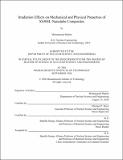Irradiation effects on mechanical and physical properties of SS304L-nanotube composites
Author(s)
Shahin, Mohammad,S.M.Massachusetts Institute of Technology.
Download1227100846-MIT.pdf (25.63Mb)
Other Contributors
Massachusetts Institute of Technology. Department of Nuclear Science and Engineering.
Advisor
Michael P. Short.
Terms of use
Metadata
Show full item recordAbstract
For decades nuclear power has been a reliable and affordable source of base-load power[1] with relatively small amounts of CO2 emissions.[2] The levelized cost of electricity generated by nuclear power plants is dominated by the capital cost of the structural components,[3] therefore extending the operating lifetime of these plants is of high economic and environmental interests. However, degradation of mechanical behavior of structural materials due to radiation damage is a key limiting factor to service lifetime. The development of advanced materials can potentially improve material performance under irradiation and increase their design lifetime. Traditional alloy design always sacrifices one property for another, such as strength for ductility, or creep strength for radiation resistance. However, a new approach promises to break this property dependency, allowing for obtaining the best properties potentially without sacrificing others.[3-5] This work aims to study the effects of introducing a variety of NanoTubes (NTs) within the metal matrix of austenitic Stainless SS (SS) type 304L on the radiation resistance of the composites. Rapid non- and semi- destructive methods are used to quantify these effects and study the correlation between them. SS and SS Metal Matrix Composites (MMCs) were synthesized by powder metallurgy and Spark Plasma Sintering (SPS) to densify bulk samples approaching the theoretical density. The synthesized materials were then irradiated by accelerated heavy charged particles to mimic the damage caused by neutron irradiation in a nuclear reactor over a longer period of time. Finally, the mechanical and physical properties of the irradiated SS as well as the MMCs were characterized and compared to the non-irradiated samples to study the effects of incorporating the NTs, and to test the hypothesis that the metal-nanotube interfaces serve as recombination sites for defects. The experimental examination of the new materials is necessary to assess their potential for future developments in reactor designs, which would allow improvements to overcome current limitations in service lifetime and hence improve the economy of nuclear power. The results show that the dispersion of NTs within the SS304L mostly caused a slight decrease in thermal diffusivity and an increase in hardness. The results also indicate that incorporating NTs did not break the correlation of property changes after irradiation that was observed in the control (NT-free) sample. In addition, all the SS matrices showed a potential inherent recovery in at least one of the measured properties when irradiated beyond 1 dpa (up to 10 dpa), which suggest the occurrence of onset of defect clustering between 1 and 10 dpa when the SS matrix is irradiated with Ni ions at room temperature.
Description
Thesis: S.M., Massachusetts Institute of Technology, Department of Nuclear Science and Engineering, September, 2020 Cataloged from the official PDF of thesis. Includes bibliographical references (pages 44-47).
Date issued
2020Department
Massachusetts Institute of Technology. Department of Nuclear Science and EngineeringPublisher
Massachusetts Institute of Technology
Keywords
Nuclear Science and Engineering.